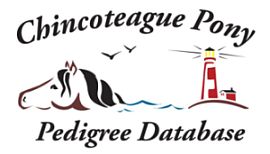
Home About Us Pedigree Search Request Changes and Additions Feral Foal Watch Assateague Herds Chincoteague Auction Statistics Help Blog
 Home About Us Pedigree Search Request Changes and Additions Feral Foal Watch Assateague Herds Chincoteague Auction Statistics Help Blog |
Need help using the database? Check to see if your question is in the frequently asked questions below. If you still need assistance please contact us! We'd be happy to help.
How do I search for a pony?
How do I find my pony in the database?
How do I find out if my pony is a Chincoteague?
How do I search for a pony on Assateague?
How do I request an update or a change to a database record?
How do I have a pony added to the database?
How do I have my pony's name added to the database?
What are the names in italics below the main name on a database record?
How do I read the information on a pony record?
What are the CVFC numbers on the record of some Virginia feral ponies?
What are the NPS numbers on the record of some feral ponies?
Why are some pony names the dam's name and the birth year?
How do I get a link to a specific database record?
What are the symbols by some ponies' names?
What's the Assateague Herds page?
Why are Maryland Assateague Horses in a Chincoteague Pony database?
Why does the database use feral and not wild?
How do I look up information on past feral ponies?
Information I saw on the database has changed! What happened?
Why do some ponies have a lot of information and others have very little?
Does a pony being in the database mean that it's registered?
What's the relationship between the CPPD and the ICPAR?
Are you affiliated with the Chincoteague Volunteer Fire Company or the National Park Service?
Why are Half Chincoteagues listed in the database?
Why are some half Chincoteague Ponies listed as Half Chincoteague and others aren't?
Can a pony that's less than half Chincoteague be listed in the database?
Why do some database records have a logo for the Etalon genetics company?
Where does the information in the database come from?
How do I search for a pony?
Begin searching for a pony by typing in the Name search box. It must be at least 3 characters or you'll get an invalid search result. Hit Submit and your search results will appear under Search Results on the left. Click on the pony you want and their record will appear in the window on the left.The options under the search box can help find a pony. The default is At Beginning. Just putting in Ace will bring up Ace's Black Tie Affair. Just putting in Riptide won't because his full name is Surfer's Riptide.
Selecting the Anywhere checkbox will bring up any pony that has that search term anywhere in their name. So putting in just Riptide would bring up Surfer's Riptide by selecting the Anywhere option. It would also bring up other ponies with Riptide in their name.
Only looking for a feral/wild pony? Check the Feral Only button so only the feral ponies will come up.
You might know a pony by only a nickname, a shortened version of their name, or by a number. Check the AKA Names box to cover all possibilities.
When you spot the pony you want click on their name and the record will come up in the main window.
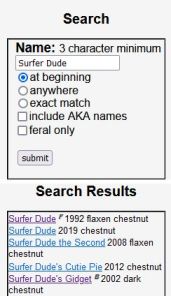
How do I find my pony in the database?
Try searching for your pony's name. It may already be on their record.
If your pony came from Assateague check Feral Foal Watch to see if we have a list for the year your pony was born.
Next try searching for your pony's dam. You pony may be listed as one of her offspring. You can can similarly search for the sire and see if your pony is listed under his offspring.
Still can't find your pony? Contact us and we may be able to find them in our research materials. We'd be happy to add your pony if it's not in the database.
How do I find out if my pony is a Chincoteague?
You're welcome to send us pictures and information to see if we can identify your pony as a Chincoteague. We'd be happy to help! There's a Facebook group that can help with identification called Identifying Chincoteague Ponies.
How do I search for a pony on Assateague?
Look for the pony the Assateague Herds list first.
Try searching for the pony and check the Feral Only box so only the feral ponies will come up. If you don't know the pony's full name check the Anywhere box and/or the AKA Names box.
How do I request an update or a change to a database record?
We do our best to keep the database up to date, but there's absolutely no way for us to know everything! That's where you come in.
Visit the Changes page to see how to submit changes. You can also email us or message us through our Facebook page.
How do I have a pony added to the database?
Visit this page (also linked on the Changes page) to submit the pony's info.
Try to fill in as many fields as you can. But it's not required to fill in ALL the fields.

How do I have my pony's name added to the database?
Visit the Changes page to see how to submit changes. You can also email us or message us through our Facebook page.
I'm a buyback donor. How do I have the pony's name added or how do I have my name added as the donor?
Visit the Changes page to see how to submit changes. You can also email us or message us through our our Facebook page.What are the names in italics below the main name on a database record?
These are referred to as AKA names and can be searched for by clicking the AKA Names checkbox selection. AKA names are primarily nicknames, but there's much more to it than just that.
For privately owned ponies past names, show names, or nicknames provided by the owner are listed. Many ponies have a prefix at the front of their name. The name minus the prefix are usually listed as an AKA name for easier searching.
For Virginia feral ponies their nicknames are listed and there may be several! Some feral ponies are known better by their nickname. The full name selected by their buyback donor or the name that was registered with the CVFC's Chincoteague Pony Association (closed in 2012) is listed as the primary name. Many ponies have multiple nicknames because their CPA registered name or their buyback donor's selection was unknown. Some ponies just picked a nickname up somewhere. To make searching easier part(s) of the full names are listed, minus prefixes and such. Ponies prior to the CPA could have multiple names so the one they are most known by is listed and the others as nicknames. Also found in AKA Names is an alphanumeric ID number that was assigned by the CVFC and Chincoteague Pony Association. The auction number of foals from 1994-2008 were their dam's ID number.
For Maryland feral ponies their Keiper/NPS alphanumeric number is listed there. If the pony only has a Keiper number for a name it won't be listed there but as their primary name. Any nicknames are also listed.



How do I read the information on a pony record?
The large block on the right has information about the pony whose record you are viewing. The block will be shaded blue for male ponies, pink for female, and white if the sex is unknown.
The pony's primary name is in large letters in red. AKA names are listed below in italicized brackets. AKA names can be nicknames, show names, former names, assigned alphanumeric numbers, or shortened versions of their primary name.
Below that is the pony's birth year (or unknown) and place of birth (if known). If the pony is deceased the death year is listed if known.
Their breeder is listed if known. A breeder is the person or organization that owned the pony when they were born. Ponies born on the Virginia end of Assateague will have the Chincoteague Volunteer Fire Company as their breeder. Ponies born on the Maryland end of Assateague will have the National Park Service as their breeder.
Next is their owner. If the pony is privately owned the owner will be listed if their owner wishes to be listed. Having the owner's name listed not required. Feral ponies on the Virginia end of Assateague will have the Chincoteague Volunteer Fire Company as their owner. Feral ponies on the Maryland end of Assateague will have the National Park Service as their owner.
The final paragraph lists details about the pony; color, markings, pinto pattern, eye color, height, birth date, death date, relationship to Misty, brands, registries, registration numbers, alternate parents, and other details.
At the bottom will be links to external websites. Such as photo albums, Facebook pages, blogs, etc.
The pink and blue colored chart on the right side has the pony's pedigree. Sire/father on the top and dam/mother on the bottom. That alignment continues to the great grandparents. Male ancestors are in blue and female ancestors in pink. The ancestor names are all links so you can click on them to view that pony's record.
Underneath the pedigree chart is a legend showing what the various symbols by pony's names mean.
If the pony has any offspring those are listed below the pedigree chart under the title Progeny. The progeny's name, birth year, color, and other parent is listed. Color coded blue for male, pink for female, and white if the sex is unknown. The pony names are links so you can view that pony's record.
Finally the pony's siblings are listed. Siblings from both the sire and dam. If the sibling is a full sibling there will be a star by the name. The progeny's name, birth year, color, sire, and dam are listed. Again the pony's name is a link and the list is color coded blue for male, pink for female, and white if the sex is unknown.
What are the CVFC numbers on the record of some Virginia feral ponies?
The Chincoteague Pony Association was run by the Chincoteague Volunteer Fire Company (CVFC) from 1994 to 2012. All of the stallions and mares in the feral herd were assigned a number. From 1994 to 2008 the auction numbers were the dam's number. It wasn't always reliable, but usually if you know a foal's auction number from those years then you can identify the dam.
The ponies in the feral herd when the association was founded in 1994 were branded with their number, usually on their shoulder. Accompanied by an F, for the fire company. The stallion numbers were S with a number. This was also when all of the feral ponies received names. Friendly Girl/Witchkraft was the last living pony in the herd with that brand. Ponies after that usually just had the birth year branded, like they do today. And occasionally with an F.
Thanks to a lot of hard work over the years the pony community has figured out many of the numbers. There's still some we know the name and number but haven't figured out which pony it goes to. Others we know the number and the pony but not the name. Or we know the pony but not the name or number.
The numbers that have been matched with names are in the database as AKA names. To search using just the number click "include AKA names". If the number is less than 3 characters add a - or two before the number in order for the search to work. If the number search is less than three characters you will recieve an invalid search result. A pony's number can be found in brackets underneath their name, along with any other nicknames. The number is listed on the record as the "CVFC number".
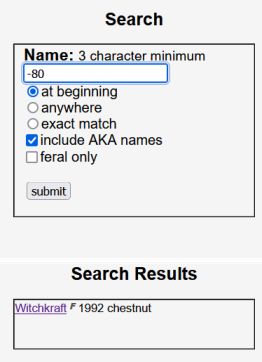
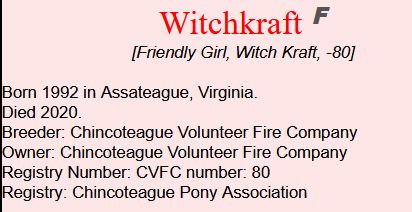
What are the NPS numbers on the record of some feral ponies?
National Park Service assigns numbers to Maryland Assateague Horses. These numbers are called Keiper numbers after Dr. Ronald Keiper who devised the system. The number identifies and tracks the maternal line of a pony.
Dr. Keiper gave each herd a letter in 1975 and then each pony a number, such as N10. A letter is assigned to each birth year starting with A in 1976. The example pony N10OY descends from the original N10, who then had N10O born in 1990, who then had N10OY born in 2000. Horses having X numbers had unknown parentage at the time they were recorded. Some lost their X designation and were renumbered thanks to a genetic study performed in 2005.
Keiper numbers can be searched for in the database by selecting the AKA checkbox. The Keiper number is listed as an AKA name and on the record as NPS number.
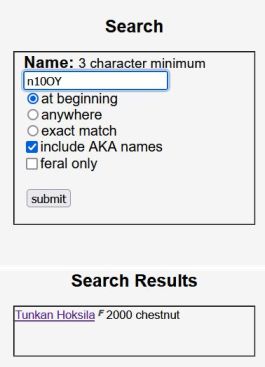
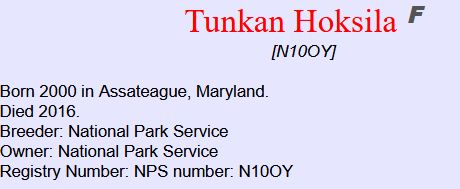
Why are some pony names the dam's name and the birth year?
These are placeholder names. We don't know the names of these ponies but we still want to have a record of them in the database. These unknown name poinies are given a placeholder name. Some will eventually be replaced by their name, but others we'll probably never find out what their name is. There are a few ponies that died young and never received a name.
The placeholder name is usually the dam's name and the year of the pony's birth. This was chosen because it's a common way of identifying young unnamed foals in other breeds. Rarely it's the sire's name and year of birth.
It's most commonly the Virginia feral ponies that may have this type of name. Occasionally it's privately born ponies. The Maryland feral ponies won't because they will still have a Keiper number if their name is unknown
How do I get a link to a specific database record?
Because the search box is in a frame you can't just copy the URL because you'll get the link to the search page instead.
You know you've got the link to an individual record if there's an id number at the end of the URL.
How to open an individual database record depends on what device or browser you're using. Follow the instructions for your device or browser to open a link as a new tab or open in a new window.
If the pony is a wild pony click on the pony's name and their record will open in a new tab. You can copy the URL if desired.
If the pony is listed on Feral Foal Watch click on "pedigree" and their record will open in a new tab. Again you can then copy the URL if you like.
What are the symbols by some ponies' names?
F means the pony is/was a feral pony living on Assateague. All Maryland feral ponies have this designation. Only some of the Virginia feral ponies do. If the pony is not a buyback (or not known if they are) then they have an F rather than a B. Some ponies were simply kept and thus don't have a buyback donor. Others were donated back to the herd later and have a donor but are not a buyback.
B means the pony is a buyback and was/is a feral pony living on the Virginia end of Assateague. A buyback is a pony that was donated back to the CVFC by someone(s). The buyback donor usually selected the pony's name. Occasionally we never found out what name the donor selected. The name of the donor is listed in the record whenever possible. We thought that having both F and B on buybacks would be redundant.
M means that pony is a descendant of Misty of Chincoteague. Their relationship to Misty is listed in the notes of the pony's record.
H means the pony is a half Chincoteague Pony. Only one parent is shown on their record, their Chincoteague parent. The name of the non-Chincoteague parent is listed in the notes and their pedigree is linked to whenever possible. Half Chincoteagues that were part of the Virginia feral herd are considered full Chincoteagues and do not have this designation.
* means the pony is a full sibling to the pony whose record you are viewing. The stars are only found on sibling lists on individual pony records.
There's a legend of these symbols on every database record.

What's Feral Foal Watch?
Feral Foal Watch lists foals born to the feral/wild Virginia Chincoteague Pony herd. The link is on the top bar. The default option opens to the current year's list.
The list has the foal's sex, color, link to photo albums, link to the foal's pedigree/database record (pops out in a new window), dam, sire, and any other notes such as birthdate. After the auction the auction price is listed, the names of the buybacks are listed, and the auction number will be listed in the notes.
To view previous years' lists select the year you want to view from the drop down menu. The menu is located in the center of the page above the title. We're always on the hunt for more auction notes to add more years and refine the data we have. If you have any notes you'd be willing to share please contact us!
Chincoteague Pony foals not bred by the Chincoteague Volunteer Fire Company do not appear on Feral Foal Watch.
Maryland foals are not included in Feral Foal Watch. They are automatically added to the Maryland Herd list since they almost always remain with the feral herd.
Information found on Feral Foal Watch is subject to change. Data may be missing or incorrect, particularly for earlier years. Please contact us for changes and corrections.
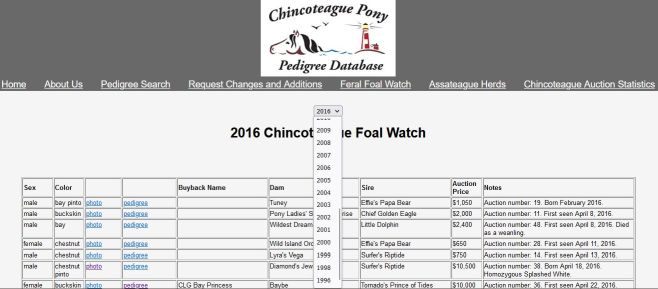
What's the Assateague Herds page?
If you look on the top banner of the database's pages there's a link for Assateague Herds. Clicking on the link will bring up a list of the ponies in the current Virginia and Maryland herds and the herd number. The list is current at the time that you view it. Both lists change as ponies are born, added to the herd, die (or maybe weren't dead after all!), or etc.
Because we are primarily a Chincoteague database, the feral Virginia herd list opens automatically. To view the Maryland herd select it by using the drop down menu by State, select Maryland, and hit Submit to populate.
The lists are automatically sorted alphabetically. They can be then sorted by Sex, Color, and Age. Use the dropdown menu next to Sort By to make the selection. Hit Submit to re-sort the list.
The pony's name is a clickable link that opens that pony's database record. Any nicknames, or numbers, or past names for the pony are in parenthesis next to the main name. The name you know a pony by may not be the one listed as the main name! Maryland ponies' Keiper number is listed as a nickname. The next columns list the sex, color, and age by year (not by birthdate).
The Assateague Herds page has an option to see a list of ponies from the past.
Find the Status drop-down at the top of the page and select Past. Then hit Submit. This will show a list of deceased feral ponies. Virginia is the default option so leaving that will pull up a list of deceased Virginia ponies. Selecting Maryland instead will pull up deceased Maryland ponies. Selecting Current will bring you back to the current feral herd lists.
Clicking on a pony's name will bring up their database record. Nicknames, past names, and identification numbers are in parenthesis. Stallions are in blue and mares are in pink. Under the age column their birth and death years are listed. If one or both of those is not known, unknown is shown instead.
Ponies removed from either feal herd will not appear on the present or past lists.
This list is of course not even close to being complete and never will be considering how many hundreds of years there have been ponies on Assateague. We are continually adding ponies and updating pony records as we research and discover more. So don't consider it set in stone!
Why are Maryland Assateague Horses in a Chincoteague Pony database?
There was little difference in the herds until 1967 when the herds were separated. Since then the Maryland herd hasn't had any deliberate introductions from the Virginia herd. But many Maryland horses have been transferred to Virginia over the years.
Initially the only Assateague Horses in the database were the ones that were transferred to the Chincoteague herd. And their ancestors and siblings. That ended up being quite a few ponies. We noticed that the Maryland community had been utilizing the database and realized it wouldn't take much effort to add the rest of the current herd. After doing so we added the current Maryland herd list to our Assateague Herds page.
Use the drop down menu by State, select Maryland, and hit the submit button to view the list.
Since doing so we expanded and have been adding every past Maryland horse we run across; regardless if they are related to any of the current herds. A list of over 300 past herd members can also be found at the link above. Select the State as Maryland if you haven't already and then Status as Past and hit the submit button. It's in no way complete of course. We keep editing information and adding more ponies to it as we come across information.
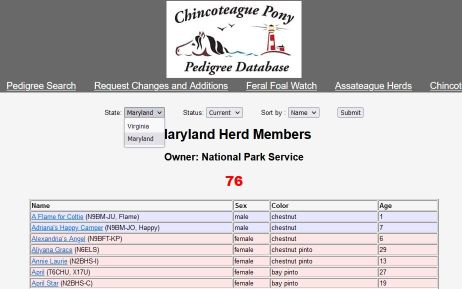
Why does the database use feral and not wild?
Feral is the accurate scientific term for the ponies living on Assateague. Visit the Wikipidea article on Feral Horses to learn more.
How do I look up information on past feral ponies?
The Assateague Herds page has an option to see a list of ponies from the past.
Find the Status drop-down at the top of the page and select Past. Then hit Submit. This will show a list of deceased feral ponies. Virginia is the default option so leaving that will pull up a list of deceased Virginia ponies. Selecting Maryland instead will pull up deceased Maryland ponies.
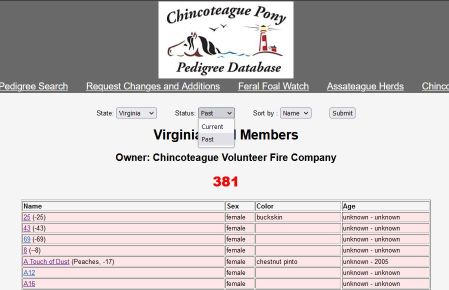
Information I saw on the database has changed! What happened?
Database information changes all the time! Rarely a day goes by without some sort of change or addition to the database. When something changes it means we found or were given more information that caused a change. Information found in the CPPD is not set in stone. If you spot something that needs chaging or adding contact us!
Why do some ponies have a lot of information and others have very little?
The database is a constant work in progress of research. A lot of information means we've managed to find a lot out about that pony. Not much information means we haven't found much on that pony, yet. We're always adding and changing information. If you spot something that needs chaning or adding contact us!
Does a pony being in the database mean that it's registered?
No. Only ponies with the International Chincoteague Pony Association and Registery (ICPAR) logo and registration information on their record are registered with our partner registry.
Ponies may be registered with other past Chincoteague Pony registries. We do not have access to their registration information. Those registrations are only listed when owners or others have provided it to the CPPD. No registry information on a record doesn't mean the pony isn't registered somewhere, just that we don't have that information.
The majority of the ponies in the CPPD are not registered with any breed association.
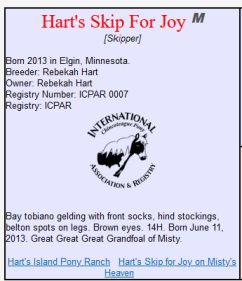
What's the relationship between the CPPD and the ICPAR?
The Chincoteague Pony Pedigree Database is the official database and studbook of the International Chincoteague Pony Association and Registry (ICPAR). The CPPD was founded in 2015 and then partnered with the ICPAR at its founding in 2021. The partnership provides an online studbook for the breed association, something that's common with many horse registries. The CPPD is a separate entity.
A pony being in the database does not mean that it is registered.
How do you tell if a pony is ICPAR registered? The association logo appears on the database record of ponies that are registered with the ICPAR. It's also written on the database record with the registration number.
Are you affiliated with the Chincoteague Volunteer Fire Company or the National Park Service?
No. The CPPD is an independent community built database. We are only affiliated with the ICPAR.
Why are Half Chincoteagues listed in the database?
Half-Chincoteagues were added to the database because the ICPAR has a registry for them. But all half-Chincoteagues are welcome to be submitted regardless of registration. Registered ponies will have the ICPAR logo on their database record. A half-Chincoteague being in the database does not mean it is registered with the ICPAR or any registry.
Half Chincoteagues are designated with an H superscript by their name.
The breed and name of the non-Chincoteague parent is listed on the database record. The non-Chincoteague parent's name is listed in the record notes. Their pedigree is not listed, but is linked to whenever possible.
Offspring of half-Chincoteagues are not loaded into the database. Any notable offspring may be listed in the notes section of the half-Chincoteague parent. They only have a database record if the offspring is by a Chincoteague Pony and thus a "half" themselves.
Any ponies less than half Chincoteague do not have database records.
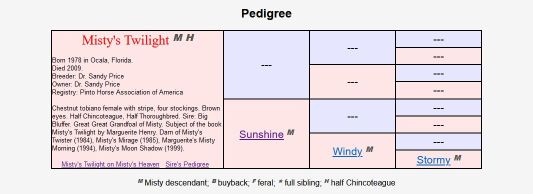
Why are some half Chincoteague Ponies listed as Half Chincoteague and others aren't?
There have been multiple other breeds added to the Chincoteague Pony breed through the decades to improve pony type or reduce inbreeding. This was mainly done by the Chincoteague Volunteer Fire Company or owners prior to the CVFC's management. These half-Chincoteagues are considered to be full Chincoteagues and thus we do too. If you purchased a half Chincoteague Pony from the CVFC it can be listed as a full Chincoteague.
There are select other partbred ponies that have been essentially grandfathered in. Those are considered on a case by case basis.
Can a pony that's less than half Chincoteague be listed in the database?
No. A pony must be at least half Chincoteague Pony in order to be listed. The ICPAR does not register less than half Chincoteagues.
Why do some database records have a logo for the Etalon genetics company?
Because of the partnership between the International Chincoteague Pony Association & Registry and Etalon Equine Genetics, if a pony was tested by them then the Etalon logo will appear on the pony's database record. For more information on this program visit ICPAR DNA & Color Testing.

Where does the information in the database come from?
Anywhere and everywhere you could think of!
-Current and past pony watchers observations and notes
-Current and past pony photos
-Dated vacation photos and videos
-Books, magazines, and newspapers
-News segments and TV programs
-Information from breeders past and present
-Old websites still active or archived
-Registration paperwork of living and deceased ponies
-Pony sale advertisements
-and on...